Wayne C. Allen's Blog, page 10
December 17, 2023
Zen for the Holidays — 10 Tips

Zen for the Holidays is a collection of hints and tips for dialing down the drama and being present during trying times.
 Psst! Hey!
Psst! Hey!** Want more great writing designed to help YOU to shift your behaviour?
** Want to learn how to find, build or deepen your principal relationship?
** Want to know more about Zen living and being?
“How often I found where I should be going only by setting out for somewhere else.”
~ R. Buckminster Fuller
Nothing ups the ante for family drama better than “going Home for the Holidays.” (You really need to see the movie…)
Typically, past dramas are minimized as people play the “this year it will be different” game.
People expect Normal Rockwell gatherings,
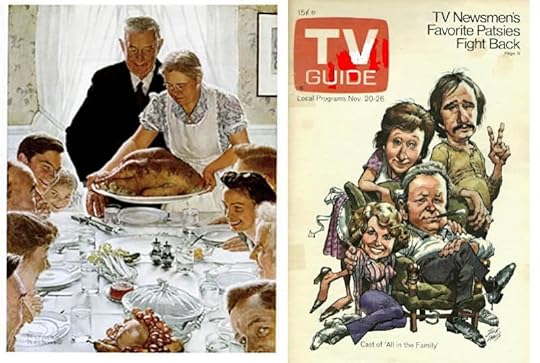
when “those gathered ’round” more closely resemble the Bunkers.
There are ways to change the game… but only if you decide to end the old game, AND replace it with something Zen.
In no particular order, 10 concepts for
a more interesting and insightful Holiday

1. Stuff the Stuff
So, how much is enough, how much is too much?
I’m an only child (surprised?) and Holiday Glut was expected. I got 20–30-40 presents, and my parents spent themselves into the poorhouse.
When Dar and I started hanging out, I persuaded her to adopt my spending habits. I’m embarrassed to admit that, in the 80s to early 90s, we spent in excess of $3,000 on each other.
One year, we set a budget. That worked.
In 96, we actually thought about our spending. We weren’t depriving ourselves year round, so why all the stuff for the Holidays? We declared a moratorium on spending for each other, and limited our spending for family members. Decades later, we still spend ZERO on each other. What a relief!
The Zen in this: Your worth is not determined by how much crap you have, and your value to others is not connected to what they give you, or how much they spend.
Time to grow up and exit Toy-land.

2. Quality Trumps Quantity
A follow on to the above, but think about it. How many hours, days, are you willing to throw away planning events, shopping, running yourself ragged, just to put on a larger dog-and-pony-show than last year? (Parenthetically, I’ve been hearing stories of kids parties costing 6–10 thousand! Yikes. Talk about trying to buy your kid’s admiration.)
Is it really that satisfying?
One client always began planning Christmas in October, and her planning was making herself miserable by reliving past disasters and predicting worse scenarios this year. Why?
“Because Christmas is really special and should be perfect!” Yikes.
The Zen in this: Instead of having an “I’ve sacrificed the most for the Holidays’ contest,” give it all up. Then, put back the bare minimum. With all of the hours you free up, spend some quality time, peacefully, with your nearest and dearest.
Internal satisfaction trumps external shows every time.
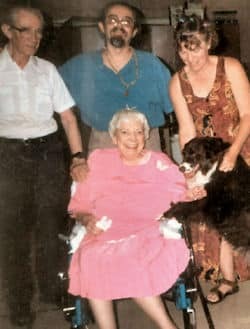 The Allens, a MacNaughton, and Jazz, 2000
The Allens, a MacNaughton, and Jazz, 20003. Your Family is Your Family
Dig out a few family group pictures.
Line them up on a table or counter, and look, really look, at each person pictured. Repeat: “These are not the Waltons. These are my kith and kin. They are as they act, and are as they are, and nothing more.”
Many people want the Holidays they see on TV, with grandpa Walton reading “The Night Before Christmas” to the kids, and everyone being of excessively good cheer.
Your family is who they are. They are how they act, year after year. Stop judging them! Just because you don’t like how they act is never, and was never, enough to get them to change.
Who do you think you are, anyway, dictating how others ought to behave?
After all, you hate it when they demand that you be different, don’t you?
The Zen in this: There is no right / wrong, good /bad. There is just what is happening. People are who they are, and act as they choose. You can’t change them, but you can change you.
This year, engage with your family (or not, see below) as they are. If someone is obnoxious, smile and walk away. Deal with the people you are related to, as they are, from the core of who you are.
If you are working on grounding and centering yourself, family gatherings are a great place to practice.

4. Develop Your own Holiday Traditions
If your family gatherings are warm and fun, by all means enjoy them, and engage fully. At the same time, see about setting up one tradition for your principal family (with your partner/spouse, and your kids, if any.)
And if you don’t much like the Home for the Holidays trip, shorten it, eliminate it, book a trip, in short, change it.
My parents are dead, so there is only Dar’s side to deal with at holidays. And for the past 10 years or so, we’ve been spending the Holidays in Spain. We do make a Skype call, though!
We’ve expanded our definition of “family” to include several others, each of whom is endearingly weird, just like us.
The Zen in this: Stop looking backward and trying to recapture or invent something. Instead, create ceremonies, activities and timetables that are meaningful for you.
Your task is to create a memorable life, for you. This requires actually doing something.

5. Cut Yourself Some Slack
Ask yourself how much energy you put into making things a certain way for others, at your expense.
Back when I was in the Ministry, I took Advent really seriously. I planned umpteen events, and ran them all.
Invariably, in January I’d be flat on my back in bed with the flu. My acupuncturist and Ninja Sensei would sigh, stick in some needles, force gag-worthy tea down my throat and ask me to re-consider.
I’d make excuses. Typically: “Yeah, but it’s winter. Everyone is sick.”
He’d reply: “That’s not the point. Why are you sick?”
The Zen in this: You are not here to straighten bumpy highways for everyone else, at your expense. Now, you may have trained your entire family to expect this of you, but no one makes you act this way. Give it up. Dial back the perfection to something fun and manageable.
This is a season that can be used to nurture, renew, and recharge yourself. It will happen when you so choose.

6. The Gift of the Season
It doesn’t matter what your faith perspective is, the holiday season is an opportunity to reflect.
It’s funny how most of the reflection gets dumped off on New Years Resolutions. And we know what happens to them.
For forever, people have used the dark days of December, and the Winter Solstice, as a time to reflect on death and rebirth, and on the gift of life.
Same with the idea of a New Year, an arbitrary date rich with the idea of new beginnings.
The gift of reflection and gratitude radiates through these days, providing we don’t leave the energy of restoration in the parking lot of the Mall.
The Zen in this: declare this year-end as a time for reflecting with your nearest and dearest, (who may or may not be family.) Note what has benefitted you in 2023, and declare an intention for 2024.
In keeping with a noble Haven tradition, pick a word that will be your ‘key’ for 2024. Develop a ceremony dedicated to personal self-reflection.

7. Engage
Many people are so zoned out and exhausted by Holiday prep that they are pretty much ‘gone’ for the Holidays.
If there is any gift to be found in the Holidays, it’s the ability to step back from the rampant consumerism long enough to engage with people you care about.
I remember one poignant moment in 2004. My dad fell on December 20, and sprained his ankle. At 92, his circulation couldn’t handle this. He developed sepsis in the leg, and was soon on morphine, then in a coma.
He died the day after Christmas, Boxing Day in Canada.
Darbella and I were with her family when we got the call. Everything stopped, and then people were hugging me. There was a palpable sense of connectedness.
Sad that for many, this only happens in times of crisis.
The Zen in this: Engage with others. Tell them how you feel about them. Hold, them, hug them, make contact. Be direct in your expressions of gratitude for others and for their gifts.
Do it ‘now.’ And then continue to enact engagement. All the time.

8. Retreat
Carve some quiet time for yourself. Each of us needs a dose of solitude, and the Holidays are a great time to take this opportunity.
If you’ve had a death of someone close to you during the Holiday season, look around for a “Blue Christmas” service in your area. You don’t need to be a Christian to go. Most are meditative, prayerful events, designed to allow those grieving to express their grief.If you have a cottage or know of a place ‘in the woods,’ go for a walk and just ‘be’ in nature. Feel the charge in the air, as the days shorten, turn and lengthen. Give thinks for living, for breath, for opportunity.Set up a family shrine. Add pictures of your family, add significant objects. Spend some time daily reflecting.
The Zen in this: Ceremonies are a part of our genetic wiring, I think. That being said, ceremonies need shifting and freshening. I used to laugh at what I called ‘Christmas Christians.’ Those were the folk who got all gussied up for the Christmas Eve service, and never darkened the door until a year later. Needless to say, they were there out of habit.
A household shrine is a great way to focus your intention and presence on what you hold dear.

9. Bake it, Make it
Another way to escape the rampant consumerism of the season is to make part or all of your gifts at home, from scratch.
Do your baking and making with consciousness and intention. Hold in your mind an image of the recipient, then let the image go and focus in on elegant creating.
Personal beats packaged, hands down.
The Zen in this: Chop wood, carry water. Need I say more?

10. Deepen, Deepen
This season is either a thing to be endured, with a fake happy face, or a time of reflection, self- knowing, intimacy and sharing–a deepening. You pick. You choose.
All moments are bare of meaning. We add meaning. Or, we go brain dead and numb and run (literally and figuratively) ourselves ragged as we attempt to avoid the pain we create.
Instead, capture this season and make it your own. Provide meaning to everything you do, real meaning, meaning significant to you. Use this time to deepen your commitment to your spiritual path, and to find more groundedness. This opportunity exists in each moment, and it’s up to you to use it.
The Zen in this: In the end, your path is yours, and you make of it what you will. Strive for more depth, more understanding. Bring yourself back to bare presence. Invigorate and enliven yourself.
Celebrate the gift of life!
Facebook TwitterDecember 10, 2023
Zen 101 — Self-Responsibility
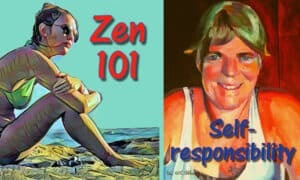
Self-responsibility is hard, as we live in a time when blame is much more popular. Nonetheless, Zen is all about self-responsibility
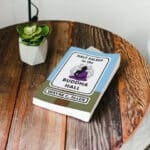
Looking for more on this topic?
Check out my book, Half Asleep in the Buddha Hall.
Wayne’s “Eastern” book takes you by the hand and helps you to find peace of mind. Half Asleep in the Buddha Hall is a Zen-based guide to living life fully and deeply.
I’ve got a couple of ideas for today’s article, and it’s really great that they’ve come from reader comments.
So, the first thing I want to talk about today is the application of the four A’s. This follows up on a point from the previous article.
The four A’s describe the internal process of working through our experiences. Step-by-step, we work through Awareness, Acknowledgment, Acceptance, and Action.
But this technique, like all techniques, is prone to a very simple misuse.We are all prone to externalize what is going on in our lives. We give ourselves credit for our successes and blame others for our failures — but what I really want to talk about is the concept of total self-responsibility.
This way of being is key to what I write about, and key to Zen. It’s the idea that all I can know is me — my thoughts, intentions, feelings — and all I can do is what I do. What others are doing only has an impact on me if I choose to create an impact.
Here’s the misuse:When applying a new technique, we may easily “get” the language, but mess with the intent.
The point of everything we talk about is to develop a state of detached awareness.
What, you might ask, is it detached from? It is detached from the need to create an emotional reaction that leads us away from simple observation of self and the experience.
The four A’s are intimately intertwined with the pronoun “I”.This is diametrically opposed to what I notice when I explain this technique. People will say stuff like,
“So I am aware that my boyfriend is a jerk, and I fully acknowledge what a big jerk he is, and I even accept but he’ll always be a jerk; where I get stuck is what to do (action) now.”
To the casual observer, this person is perfectly following the “4 As” technique, as she lists off the four aspects. She clearly “gets” the language.
But it doesn’t take great wisdom to see that the subject (the use of the 3rd person pronoun) of the 4 A’s totally misses the mark. She’s using the technique to maintain blaming and externalizing.
Here’s a more elegant application of the technique:“So, I am aware that I have a tendency to judge my boyfriend, and I acknowledge my judgmental streak. I further accept that this is a part of my personality, and is an issue I want to work on, so it is my intention (this is how I will act) to notice, and stop myself when I shift into judging.”
An entirely different kettle of fish, eh?
The problem is that talking about someone else’s fault(s) solves nothing. It just reaffirms what we already believe. And endlessly lecturing another person on their perceived faults, while using ever more sophisticated techniques to try to make them change is still nothing more than bitching, moaning, and complaining.
Zen Lesson #9 — the pronoun is “I”
There is no easier way to say this – your job is to pay attention to you.
We hear this and tend to react by saying, “…but that’s so selfish!” I suspect people toss out the “selfish” word as yet another way to stay focused completely on (the “sins” of) others.
One of the chief lessons that comes from Zazen is the awareness of just how much crap our minds generate. We’re always looking around, judging, criticizing, blaming. It’s what our minds do best. This does not change the point.
Nothing in your life changes if you don’t change it. Your pain doesn’t stop until you stop hurting yourself.
There may be a grim satisfaction that comes from blaming others, but all you get is that grim satisfaction — nothing else changes — and there you sit, in a pile of mud of your own creation.
The solution is endless application of the four A’s, using the pronoun “I”. Here is who I am, here is what I am doing, here is what is working for me, here is what needs to stop. And then… wait for it… you actually have to do it!
Zen Lesson #10 — there is little we can knowI received a blog comment regarding the last article — and intrigued myself over the last sentence.
“When you don’t have that mindset it’s a great challenge to get your mind thinking in a different direction as long as you know it will benefit you.”
The mindset he was describing is doing as opposed to just thinking.
I’m not particularly interested in noticing how the writer describes acting as “thinking in a different direction” — what he is really describing is getting caught in a thought loop that goes nowhere — and how difficult it can be to escape this pattern.
What I want to say something about is the last clause:“… as long as you know it will benefit you.”
Life in the 21st century, especially in the West, is built on the flimsy foundation of (eventual) reward. Virtually everything we buy is sold on the basis of all the great things that are going to happen–eventually–if we buy the product.
It’s like the really old joke:
Two Newfies are visiting Toronto. They discover they have a five dollars between them. They really want to have a bunch of great experiences. One of the guys takes the sawbuck and goes into a drugstore. He walks out with a box of tampons. He says, “Problem solved!” His friend says, “What are you talking about?” The guy says, “I saw it on TV. You can go horseback riding with Kotex, you can go swimming with Kotex, you can go dancing with Kotex…”
Anyway, it’s really silly to think that we focus solely on future benefit.When we teach the communication model, we often hear, “I’m willing to try this, but only if my partner does too.”
And then they go on to explain that in the past, their partner has let them down, and therefore will likely let them down again, and they don’t want to put all that effort into learning how to communicate before they can be totally assured that it’s all going to work out the way they imagine it might.
We demand assurances because we fear death — the greatest uncertainty of allMost of us hate thinking about dying, and do whatever we can to avoid the subject. We even use euphemisms for death — “passed away,” “moved on,” saying, “I lost my mother,” to which I often reply, “Do you want help looking for her?”
Because of this innate fear of the inevitable, many are endlessly looking for assurances and security. We’re willing to stay stuck in deadly situations — deadly for our hearts, deadly for our souls — if someone cannot or will not promise us in advance that doing something different is going to make it all better.
And no one can.
John Lennon had it right when he sang, “Life is what happens while we’re busy making other plans.” Within a very short time after recording this line, he was shot and killed by a deranged fan. There are no assurances, about anything! This is just the way it is.
So the important question is, what can I do right now to fully and completely live my life in this moment?It is impossible to know now what will benefit me in the future.
You might have to wrap your head little bit to get around this one, but imagining an outcome and experiencing an outcome are absolute opposite things.
So, let’s go back to the idea of the communication model, or the four A’s –
You can sit there and think about what might possibly happen were you to use either or both of these techniques. You can draw pictures in your head, have conversations with imaginary people, think about outcomes, think about differences, and at the end of the day you know precisely nothing.
Or, you can do the communication model, you can use the four A’s, and then you can see what actually happens. If you like it, do more of it. If it doesn’t work, do something else.
Doing things this way is direct and simple. You do something, you evaluate the results. No one else is involved — it’s just you observing you. The more you apply the technique, the easier it gets, and the more interesting the results become.
This is so with anything we learn — it’s hard until it’s simple.Today’s lesson is this. Zen living is not an intellectual pursuit — it’s a way of acting and being. When sitting, you sit. When communicating, you communicate. When eating, you eat.
Nothing we do is for an eventual benefit, because there is no eventual. There is just the now in which I act, and now in which I observe the results of my action. No assurances. No manipulation. No games. Just living with attention.
Facebook TwitterDecember 3, 2023
Zen 101 — More Zen Ideas

More Zen Ideas — learning to act on our beliefs as opposed to just spouting them is the work of a lifetime.

Looking for more on this topic?
Check out my book, Half Asleep in the Buddha Hall.
Wayne’s “Eastern” book takes you by the hand and helps you to find peace of mind. Half Asleep in the Buddha Hall is a Zen-based guide to living life fully and deeply.
 Waddya mean
wake up
! I am awake!
Waddya mean
wake up
! I am awake! Why don’t you ever believe me?More Zen Ideas
I once worked with a client, and much of what we talked about, and did in Bodywork, was both fascinating and predictable.
Predictable, because she continued to make her life miserable by repeating the same dysfunctional behaviors. Fascinating because she was quite bright and totally “got” what we were talking about.Doing things differently? That’s another story.At one point, she said, “You make all of this sound so simple!”
Darbella and I talked about that one afterward. Dar made (as usual) a good point. Paying attention to the present moment is both simple and hard, and is neither simple nor hard.
It only gets to “simple” or “hard” when we get involved withthinking about doing, as opposed to doing.
Dar mentioned a reaction she has to one of our Zen teachers, who often talks about how “hard” Zen practice is. He sighs a lot. Dar’s comment was, “It’s not hard, and it’s not easy. It’s just whether, in this moment, you do it or not.”
How Zen of her.One of the “rules about sitting” is: “WHEN you distract yourself by following a thought, bring your attention back (to the breath, to the moment, to nothing… to whatever is “up” right then and there.)”
Notice the when, as opposed to if.
Think about it: if losing focus was something we are supposed to get past, why the continual reminder to simply pay attention again?
One of the chief distractions is grasping onto a sense of “this is hard” as a way to stay the same. In relationship counselling, “This is hard” is short-hand for “Why the hell should I have to change when it’s his/her fault?”
Hint: because the only thing you have even slight control over is yourself.
Continuing our count from the last article:
More Zen Ideas #4 — Drop Judgement
Yeah. I know. Impossible. None-the-less, let’s hold this one as a part of the discipline, eh?
Hard, easy, good, bad, right, wrong, at fault, innocent,
all are judgements as opposed to statements of fact.
“It is 28 degrees Celsius today here in Álora, Spain” is a statement. “Jeez, is it ever hot today” is a judgement.
Dealing with aspects of life — birth, illness, disability, death — is neither hard, nor easy. What it is, is both predictable and necessary.
Being present, using excellent communication, releasing blocks, getting over oneself — again neither easy nor hard.
It’s simple, though.Once all of the excuses are out of the way, there is this: am I doing it, or am I not? If I am not, I can start, or I can yell at myself.
See? Simple.
More Zen Ideas #5 — Awareness — Being Aware
Back in the good old days, The Haven promoted the 4 As — Awareness, Acknowledgment, Acceptance, Action.
They’ve since added an A and a B. (Breath & Appreciation.)
Anyway, I suspect that much of what we talk about here can be framed within the context of the original 4 As.
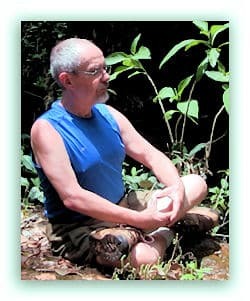
Sitting in meditation — Zazen — is the one and only method for Zen practitioners to achieve what might be called ‘simple awareness.’
This is awareness unclouded by judgement.
Mostly, people are spectacularly unaware of anything beyond their stories and judgements.
My principal goal is to get you to devote your life to awareness, which then leads to the other three As.
Now, of course, within awareness is noticing my attempt to go non-present.
I call these NPMs — non-present moments.
Bare, or simple awareness is awareness unclouded by excuses, ego, or blame. Items that come into awareness are ‘as they are,’ and are worthy of simple notice.
More Zen Ideas #6 — AcknowledgementAcknowledegment sort of means to know you know.The dictionary suggests, “admitting to knowing something” as a definition. Stress on admit.
The Zen practitioner, as she notices the arising of thoughts, judgements, “dual thinking,” freely admits to what is happening in the mind. But the essential acknowledgement is this:
This is me, separating myself for the actual experience of the situation at hand (the moment,) as I turn my thoughts into something more significant than the situation itself.As I notice (become Aware), and then acknowledge what I am doing, I find myself able to choose.
Sometimes, I really, really want to blame and judge.There is nothing wrong (at all!) with any choice, so long as it is a conscious choice, AND I am willing to accept complete responsibility (the consequences) for my choice.
We’ll get to action in a minute, but at this stopping point, let me be clear: we have almost no control over what we think, and therefore our thoughts are harmless and blameless. What we do with our thoughts is another matter entirely.
More Zen Ideas #7 — AcceptanceReread the intro, and the “it’s hard” stuff. This is NON-acceptance. This is how we get up into our heads and excuse our stupidity and laziness.
Acceptance is quietly and completely owning who I am and what I do, (i.e. have NPMs) — without judging “hard,” “bad,” whatever. As I accept that I do have NPMs repeatedly, I can have it, notice it, and let it go. As opposed to the relentless search for the “reasons.”
Acceptance is living with yourself as you are, warts and all, without judgement, blaming, or looking for the “reason.” “Why am I in this mess?” is a common counselling question. The answer is, “Because of choices you made, and because, sometimes, shit happens.” Ruminating endlessly is not helpful. Acceptance of the reality of this “now” is essential.
More Zen Ideas #8 — Action
The first 3 As lead to action.
Action, as I mentioned last article, is of the “Chop Wood, Carry Water” variety. Going into your head to make yourself more miserable is not an action. Getting off your butt and doing something meaningful, now, is what action is all about.
This is where the rubber hits the road, so to speak. All I can do is what I can do.
My actions need to be clean and pure, from within the container of my belief system.
Thus, my actions match what I say that I believe to be true. My only job is to bring myself under my own discipline.
This week, contemplate your relationship to points 4 to 8. Commit to seeing the truth of you, and from there to being you by living and enacting you. Moment by moment, of course!
More Zen IdeasFacebook TwitterNovember 26, 2023
Zen 101 — Essential Zen Lessons
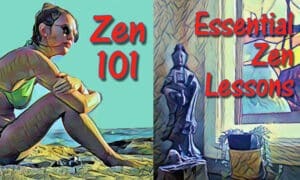
Essential Zen Lessons — Coming into presence is the key focus of Zen, and is accomplished in Zazen and “simply noticing. Here we begin to explore the foundations of building an “attentiveness practice.”
 I made it! I’ve arrived! I’m the best!”A series on learning and living zen
I made it! I’ve arrived! I’m the best!”A series on learning and living zenBack in the day I read the June 2008 cover story of Psychology Today - “Dare To Be Yourself.” The problem with it is that it is decidedly results oriented, as something from a Western perspective would be. While it describes living with flexibility and flow,
it’s clear that such an approach is seen as a technique to get somewhere — to being authentic, (Whatever the hell that means.)Well, gag me with a spoon.“I want to be authentic, real, who I really am,” is often short-hand for, “I want to continue to do stupid stuff that doesn’t work, and get others to behave, so that I can be happy.”
It’s why so many people are so sappy when they “fall in love.” There’s all this emotional vibration going on, and it’s a distraction from the underlying dissatisfaction the un-examined life brings.
Zen, on the other hand, is all about “is-ness.”In other words, what is going on inside of you — all of the mess, and game playing, blaming and drama, — IS your life. As is whatever your body is doing, moment by moment. To again quote the amazing Taoist, Stewart Wilde, “The way it is, is the way it is.”
I would say, “The way it is, is the only way it is.”
There is no getting past who we are, thereby achieving some state of bliss where everything is, well, “just perfect!” Perfect is just one more goal — one more “judgement point.”
The prevailing western myth is that the goal of life is happiness. From a Zen perspective, all that is possible is to be present. Or perhaps better put, all that is possible is the awareness of being present — it’s not that being present is a choice, after all.

Looking for more on this topic?
Check out my book, Half Asleep in the Buddha Hall.
Wayne’s “Eastern” book takes you by the hand and helps you to find peace of mind. Half Asleep in the Buddha Hall is a Zen-based guide to living life fully and deeply.
Here’s the first three Essential Zen Lessons.Essential Zen Lesson 1 — Be PresentIf presence is all there is, why is it so hard to be so? Well, let me re-introduce you to your egoic mind structure.
For me, the odd part about the Psychology Today article is that the writer is caught in the “authentic self loop.” This is the idea that people are actually both real and “substantial.” Our minds do this to us by constructing stories of past and projections of future.
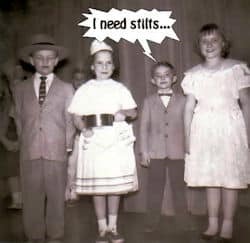 Me in the land of giants…
Me in the land of giants…This is a photo of “me, age 8 or thereabouts.” Who is this person? Does he exist? Where?
If you say, “That is you then, and you are now who you are now,” there is no way to prove that. You’d say, “Yeah, but genetically you are the same.” No way to prove that. Even if you had a genetic sample from “then,” there’s no way to prove it came from “me, then.”
None, not one, of my cells is the same as his were “back then.”
In other words, the picture captures a frame in a movie.He existed like that in that moment, and never before or since.
If I think I am actually him, then I will concoct stories about him; about how he was back then. But any story would be based in my “now.” What he was thinking, who he “was” back then — a mystery!
I actually have no clue about what this picture is of. I recognize the girl to my right, and she seems to be collecting the offering at school, which makes no sense. So, I’d have to invent a story.
Which is what you do, every time you describe yourself.
Presence is bringing your attention, continually, to the frame of the movie that is “now.” In this sense, it would be Zen-ish to say that we are processes as opposed to fixed realities. In each moment, with each breath, we come and go, are born, and die, and are born again. Hard concept, since all those memories and stories seem real.
A couple once assured me that they would always be “in romance” with each other. They imagined that they had been “in love / romance” for 8 months, after all.
Since they were pretending they could predict the future, I invited them to remember the beginning of other relationships, when they had felt the same about past lovers. They briefly looked sheepish, then spoke in unison, “This time, it’s different!” (Of course, they are right, but for another reason entirely!)
Desperation here, folks. I feel good right now, and I want this to last forever, while getting “better and better.” Yet, there is no forever. There is just this moment, and my choice as to how I will be in it. To think of the future is perverse, as it actually takes me away from this moment, and “here, now” is all there ever is.
Essential Zen Lesson 2 — Drop Clinging
Sure, I’m speaking impossibilities. It’s not possible to never cling. (Double negative! Wow!) However, we can notice and let go.
Clinging has three forms. We pull what we want toward us, we push away what we hate, and we are neutral to much of our experience. All of this is done in our heads, as we judge the object of our intention.
Wanting more is the state of mentally grasping onto something pleasurable as opposed to experiencing the now.Pushing away is mentally creating abhorrent stories, as opposed to experiencing the now.Being dis-interested is escaping into your head, where you judge that your fantasies are “better” than experiencing the now.
Clinging is all about thinking that your thoughts about living are better than actually living. Clinging is thus a judgement — a mental evaluation of something past — a setting up of scenarios that are then compared with the now.
All fighting is caused by this. I have a thought about how you should be, I judge that you are not as I want you to be, and therefore, if you love me, I decide that you should want to fix yourself so I can have my fantasies match reality.
I judge that how I imagine you should be is more important than how you are.Yet, when someone wants you to match their belief of how you should be, you get all bent. Weird, eh?
Engagement in the here and now is simple presence.This, then this, then this. No thought of “all of this should be different.” That’s clinging to a thought. Instead, do something different, do what you are doing, or leave.
Way too simple, eh? After all, you are here to tell everyone else what to do, right?
Get over it.
Essential Zen Lesson 3 — Simplify
We create complexity to build a sense
of importance and drama.
I saw this with clients all the time. They’d report some event, and they’d blow it up to such “largeness” and importance that I was surprised the thought didn’t explode.
They’d put hours and hours (sometimes years and years) into their story, and there were twists and turns and pauses and tears and lots of drama.
I used to do this a lot. I’d go off to my therapist, Gloria, and tell her one of my “tragic tales.” She’d listen, shake her head, and say,
“Cute, but stupid.”I’d sigh, and let go of the story.
I’m not smart. I’m just good at dropping my drama. I see me hurting myself and decide, for this moment, not to.Ram Dass used to talk about “Nobody Special training.” Same thing. We want to be significant, noticed, important. We’re not. No one is.
Story simplification is this: “This is it. How it is right now is how it is, and in the next moment it will be that. Me too.”
This does not preclude action. It’s like me and Gloria. Her action is to point out my inattentive story making, and to invite me back to the present. It’s a short, sweet approach to therapy and life. If she chose to engage in debate about my stories, she’d join me in magnifying them.
Simplification extends to all of our actions. It’s the meaning of “Chop Wood, Carry Water.” When chopping, chop. When writing, write. When working, work. Let go of the need to bore yourself or distract yourself. Do what the present moment requires.
Facebook TwitterNovember 19, 2023
Real Relating — Discover Yourself
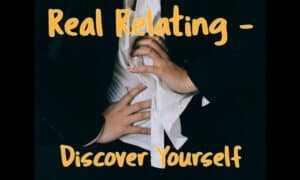
On Real Relating — Discover Yourself — relating is a forum where we get to experiment with what we are learning about ourselves

Want to learn more about living a full and meaningful life?
Want to have the best relationship ever?
Check out my books
Today is our last look at David Schnarch’s amazing book, Passionate Marriage.
To recap, his states that our job, when relating, is:
to stand on our own two feet,to work on those aspects of our self that are getting in our way, andto self-soothe in the face of opposition.So, my only job is figuring me out, resolving my issues and standing forth in my ways of living and being.Because of this, I want to be with a partner who is doing exactly the same thing. This means that I will not be in relationship with anyone who wants me to put his or her needs or wants or desires ahead of my own. Period.
A quote, for this week, from Schnarch:
“Basically, constructing your crucible involves extracting your unresolved personal issues embedded in your gridlocked situation and confronting them as an act of integrity. You do this unilaterally, without counting on your partner to do likewise, and without getting lost in what he is or isn’t doing… You focus on yourself instead of “working on your relationship” or trying to change your partner. You stop trying to make your partner listen, validate or accept you; you listen to yourself.” Pg. 234Author NameTweet

Back when I was in Seminary, one of my friends was a “seeker of the perfect partner.”
When we first met, she had just divorced her first husband. He was a psychiatrist, and her description of the process they engaged in was,
“I married him because he stood up to me, didn’t just cave in. We argued all the time, trying to get the advantage. I finally left him when I realized that we were never going to be able to resolve anything.”
The marriage had lasted less than 6 months.I asked her what it was about her that wanted to be at war with her partner. She said that she thought that conflict and arguing were signs of real life — of passion. The verbal pushing and shoving matches showed the depth of her relationship. She was “engaged.”
The problem with this was that was all there was — the fighting, the blaming, and the exhaustion. I suggested she get some therapy, so she could get over herself and so she could explore her desperate need to win.
She just laughed and went on a man hunt.That summer, she went off to be the summer director of a church camp. That put her in contact with a series of men. She wrote to me weekly, describing in glowing terms the “male of the week.”
By this I mean that she “dated” and bonked a different man each week, and each “relationship audition” lasted a week.The first week, she also wrote that shehad figured things out — all by herself!! — no therapy necessary.
And what she figured she wanted was a man:
who was sweet and kind andwho would listen to her and respect her andwho would let her be in charge.Her need to be in charge of someone else stemmed from a deep resistance to taking responsibility for her life; she wanted others to change so she could be happy.
With the psychiatrist ex-husband, that meant winning fights. Her latest goal was a man who would do whatever she said.
Unfortunately, none of the men she serially dated seemed to be “into” such obedient behaviour. Male after male passed through; none of them had the right stuff. I know because she kept sending me letters.
The summer passed. By late August, she’d “auditioned” the entire Board of Directors; 10 of them!Finally, with one week remaining, all that was left was the camp janitor… or so she told me in her final letter.
I went to Michigan to pick her up and haul her back to Toronto. Imagine my amusement, when I arrived. I found a note on her door saying she was with “Biff” or whatever his name was.
She said I’d find her in his van.
And damned if there wasn’t a bumper sticker on the van, reading, “If this van’s rockin’ don’t come knockin.” And it was. Rocking.
She emerged flushed and grinning. Biff, she told me, had turned out to be just perfect.
Over dinner I learned his favourite expression was, “Yes, dear, whatever you say, dear.” He clucked and cooed and even cut her meat for her. She was in charge, and she was revelling in it.
So, she married him.Three years later, she showed up, unannounced, on my doorstep. She was leaving him, she said, amidst tears. Why? “He never has an opinion. He leaves everything to me. The sex is boring. He won’t stand up to me.”
When I pointed out that these were the very things she had told me, 3 years earlier, were his strengths, she said that I had mis-heard her.
The next guy she dated was a shell-shocked war veteran who couldn’t feel, and she was determined to teach him. After 6 months, she left him because he refused to change.
The last guy I heard about was 30 years older than her and had just had a triple bypass following a heart attack. I joked that she was with him because she’d realized that, so far, all she’d missed out on was being a widow.
She did get therapy, from a guy she called “Donny.” (Shades of Annie Hall.) He told her she was fine — it was the men.
I haven’t heard from her since ’87. She hated that I continued to suggest that she get her own stuff together, and figure out why she had such control issues. She thought she had nothing to learn.
Schnarch:
“Yes, we all marry “for better and for worse,” but the assumption is that spouses will do everything possible to overcome their limitations — not simply demand their partner put up with them!“
pg. 302
So, assuming you have a partner and you’re stuck, and you’re willing to look at yourself and your stuff, what will be required?
Well, first of all, you need to get off your partner’s case, take a step back, and spend a while doing self-exploration. This involves admitting that the cause of your distress is you, not your partner.
Now, your partner is likely not going to make this process easy. Unless they have, by some miracle, agreed to do their work precisely when you decided to do yours, their goal will be to get you hooked back into their messes — by doing the old stuff, cajoling, blaming, picking fights. They do this because, as you change the rules through self-exploration, they feel threatened, as the focus goes off them and the relationship to you.
Do it anyway.One last Schnarchian quote: (from a case study)
“At breakfast the next morning, Joan expressed her feelings without focusing on Bill’s reaction. “I’m no longer willing to accept how rarely we talk,” she said, “and I’m no longer willing to push you to do it. But don’t assume I’m accepting things the way they are because I won’t be nagging or criticizing you anymore. For myself, I don’t want to be pathetically grateful just because my partner talks to me… And for you, I don’t want you feeling pressured all the time by a screeching wife. I’ll interpret what you do from here on as indicating your decision about how you really want to live. I make my decision about my life accordingly.”” Pg 122
The key to amazing relating is changing one’s self-view, and from that place, changing the way we interact. Without exception, the life you lead, you live, is the result of your skill at self-knowing.
Buy Schnarch’s book. Find a competent therapist. Stay with it. (Or start…)This is, after all, the only life you have, and likely the only one you’ll get.Facebook TwitterNovember 12, 2023
Real Relating — Finding YourSELF
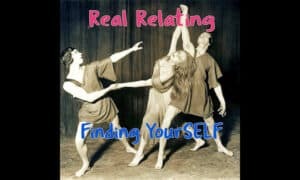
Real Relating — Finding YourSELF — Most people enter relationships either for what the other person will (endlessly) give them, or to ‘help.’ Neither approach works.

Note: If your present relationship needs work, well…
check out The. Best. Relationship. Ever.
It’s my relationships book… you’ll find all the help you need!
Just a note: I’m pulling quotes from Passionate Marriage, by David Schnarch.
Relationships are funny things. Or, at least the reasons people enter them seem funny.Our opinion is that relationships are the perfect learning and proving ground for figuring yourself out. Yes, you read that right. YourSELF.
Because like it or not, you are the only person on the planet who can figure you out.
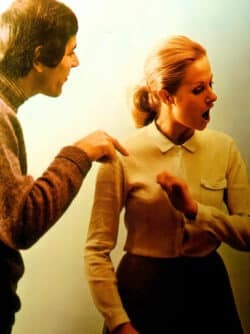
This flies in the face of the traditional belief. Which has always struck me as weird. Many people get married either to have someone to look after them, or to have someone to blame for who they are and how they are screwing up.
It’s a hard thing to give up on blaming others for what isn’t working in your life — our society loves victims and encourages them to keep being victims. People love victim-mode; it’s a way to avoid confronting themselves. David Schnarch describes one mode of this as “therapist shopping.”
It often goes like this:
Client comes in and lists off a tale of woe. Said woe is emphatically external.They were parented wrong (who wasn’t?)Their partner disagrees with them (whose doesn’t?)They’ve had therapy and done a pile of workshops, but their circumstances won’t change (why would they?)They’re physically or mentally anxious (part of life)Now, you’d think that a person in therapy would be there for the long haul, and be would willing to deal with their issues by changing how s/he is acting.This is often not the case. For many, no matter what brought them to therapy — relationship breakdown, physical symptoms, mental distress — whatever — what many clients are looking for is justification to stay the same.
The goal for them is not self-regulation through discipline. Their goal is symptom removal.As Schnarch puts it in Passionate Marriage,
…we never doubt that therapists have clever tricks to get us around our problems without going through them. Few of us enter therapy to change ourselves — we are usually seeking ways to change our situation or our spouse, while we remain the same. We seek out simple tips, techniques, and benedictions that tell us how to communicate and be compassionate (read: easy ways to feel understood and receive compassion.) pg. 322
Many people get married either to have someone to look after them, or to have someone to blame for who they are and how they are screwing up.
I remember having one session with a couple. They were separated. He described himself as “controlling,” and as the session went on, all he would talk about was what he needed from his wife.
He was lonely, he was unhappy; he needed his wife to end the separation, come home and look after him. He told me that he had done 2 sessions of anger management… and now he had been to couples therapy. He figured he had done his part
He concluded with how badly he needed her to look after him, to affirm him, and to tell him he was a good and worthwhile person. Oh. And how she needed to let him be as he was; angry, unstable and controlling.I was pleased to note that she was not biting on his neediness, and was not rushing home. She was holding her ground.
He had pushed her a few months earlier, and she wanted to talk about her fear of him.
He laughed it off. Said she was painting him as being violent. That normally he only yelled and threatened — the push was a fluke. He reminded her that he had done “2… 2! anger management sessions!”
She went inside, calmed herself, and said, “I hear that you’re hurting, and I’m not coming home until I feel safe.”
Boy, did he piss himself off over that one. (I guess those 2 whole sessions of anger management hadn’t “taken,” eh?) He yelled, he cajoled, he paced.
Then, he decided to come after me. He told me in no uncertain terms that he was angry with me because (it had been 30 minutes, after all…) I wouldn’t help him get his wife to come home… to understand that she should have nothing better to do than endlessly try to make him happy.
It was clear by then that I was heading in the opposite direction — I’d suggested a 3‑month trial separation, with each of them doing individual therapy. I’d said that I thought that both would benefit from growing up, getting over themselves (she wasn’t off the hook — she was an enabler and needed to look deeply at her enabling behaviours) and standing on their own two feet.
The man paced the office: out to the waiting room, back and forth. He shouted that all of his friends thought that his wife had an “imbalance of power.” (He meant: “I’m supposed to be in charge here. How dare she assert herself and not look after me?”)
I said that I got it that he didn’t like the situation: that his wife was learning to look after herself. I then said that it was not her job to look after him… it was his job to look after himself.
He said, “This is not how therapy is supposed to be going! She’s supposed to see that I did what she asked (2 anger management sessions, 1 session of therapy…) and come home.” (Read: “Wayne, if you were doing your job, you’d tell her to come home.”)
He knew I was a former minister, so he trotted out, “Show me in the Bible where it says that I should stand on my own feet, and that my wife shouldn’t look after me!” I just smiled and repeated myself. He kept shaking his head and muttering, “You’re not doing this right!”
They booked another session. Quoth the woman, “This has been great!!!” Husband glowered.Several days later he called and cancelled the next session. He had decided that they would get counselling at their church, where, I am sure, he hoped to find a Minister who had read the same Bible he had invented.
My only regret was that she went along with him. I would guess that his manipulations finally caused her to give up on her self and return to “doing it his way.”
Problem is, as long as one partner tries to control the other, the relationship is doomed. Or as Schnarch puts it,
Long-term intimacy within marriage hinges on validating yourself rather than “trusting” your partner to make you feel safe. Pg. 113
To repeat what I said above, my life is not about me understanding other people. Nor is my life about demanding that other people understand me. My job is to figure myself out.

I can listen as others choose to self-reveal. I can even attempt to help others cut through the bullshit they tell themselves.
One of the biggest is, “I just gotta be me!” Nothing holds you back more that “being yourself.” Being yourself is code for “I refuse to do the hard work of shifting what isn’t working. Being yourself has led you to where you are right now.
We all need to get over “being me,” and decide to grow up.
Growing up means hearing hard truths about ourselves (which our partners definitely will point out to us — this is the real reason for being in a relationship in the first place — for the feedback!)
Rather than get defensive and run around whining about being ill-treated, I go inside, and self-soothe.Once I’m calm, I choose to look at the criticism and decide if my behaviour needs changing. I then choose to change, not for the other person, but for myself.Schnarch: My point is: communication is no assurance of intimacy if you can’t stand the message. “Good communication” is often mistaken for your partner perceiving you the way you want to be seen or understood. “We don’t communicate” is code for “I refuse to accept that message — send me a different one! How dare you see me [or the issue] that way!” pg. 102
In my book, This Endless Moment 2nd. edition, I wrote:
The Kayak
This is one of my favourite stories and is my take on an illustration David Raithby used in a workshop at The Haven.
My life consists of me, sitting in my one-person kayak. I am bobbing along, paddling along, on a relatively calm ocean, in the dark. I do not know where I am, or where I am going. I am “present” in the paddling, and nowhere else, as there is nowhere else.
Every now and again, I meet up with another paddler, and we get to choose whether to paddle together. We still don’t know where we are or where we are going, but we are no longer lonely. I am, however, and this is key, still alone.
A single kayak is an interesting boat. There is only room for one. No one can climb in with me, no one can take over for me, and no one can paddle my kayak for me. I am alone in my kayak, even if other boats surround me. Whining about how unfair all of this is, how I need help, how I want someone to please take over for me, isn’t going to accomplish anything, as no one can step in and bail me out.
What I can do is watch others paddle, and they can watch me. I can learn from others, and others can learn from me. Now, someone watching me paddle will see how I do it, and then they might try to duplicate my stroke, from their boat. The best they will ever do, however, is their version of my paddle stroke. They can’t be me; they can’t be like me. They can only watch and learn and do it their way.
This is the reality of life: we are born and die alone, and the rest of life is a solo job in a crowd. This is either terrifying or freeing. I’ll scare myself with it precisely to the degree that I refuse to accept responsibility for my life. I will free myself precisely to the degree that I allow myself the personal satisfaction of paddling just a little more efficiently and effortlessly each day.
There will be calm days and stormy days, and days when I’m swamped and flipped over. I can drown or I can get right side up. Whining about how unfair that is only delays getting back to paddling, which is the only “truth” of my life.
In other words, I can see my life as a lesson in elegant paddling and I can learn all there is to learn about paddling well. A silly choice would be to feel sorry for myself that I must paddle. Another silly choice would be to spend my days assigning blame to others for not rescuing me or teaching me “right,” or for “abusing me” by not treating me as special or whatever. For the ultimate in silly, I can simply give up, depress myself and stop paddling-and get blown wherever the wind takes me.
Deciding to paddle well, to accept that “the way it is, is the way it is,” is the enlightened choice. I want to be the best me I can be, and that’s totally about me-about what I choose to learn and do.
Further, I can choose to paddle with others who get this, and the paddle will be full of sharing and compassion and learning. Or I can choose to paddle alone and learn more of me.
I mean, what other option is there? It’s not like griping about “how life is” changes anything, after all. You have noticed that, haven’t you??
There’s the joy of the paddle and smart vs. dumb choices. The dumb choice is to make a drama out of the paddle and make myself miserable.
And isn’t it funny that most people pick drama over the joy of the paddle?
In my little boat, I am alone, and self-responsible. No one is “supposed” to make it all better for me. That’s my job.
Given that, what of relationships?Darbella is in her boat, too. I can’t do anything for her. We can, however, choose to paddle along together, and keep each other company. I reveal to her what I know about myself, and especially the embarrassing, stupid, messy parts.
She may choose to do the same, although it’s not a requirement.
Here’s the important part: I choose who I paddle with… and I choose to be with someone who is choosing to self-reveal to me.
It is impossible to live life free of anxiety. There is the anxiety of relating — which requires change, and pain. There is the anxiety of trying to stay the same, in denial, pretending.
The fire of true relating, to me, seems the better choice.
Facebook TwitterNovember 5, 2023
Real Relating — I Wasn’t Going to do This
 Real Relating — I Wasn’t Going to Do This
Real Relating — I Wasn’t Going to Do ThisOn Real Relating - I Wasn’t Going to Do This — learning to work through emotions without turning them into issues is a relationship must

Want to learn more about living a full and meaningful life?
Want to have the best relationship ever?
Check out my books

“I wasn’t going to do this.” A most fascinating “client line,” one I heard in exactly the same context throughout my 32 year counselling career.
The line was always spoken precisely 3 seconds after the first tear coursed down the client’s cheek. The tear, combined with a rueful smile and a stifled sob, was the marker of a client that had gone a step deeper into their SELF.
This, as opposed to all the “gimmicks” clients brought with them to avoid doing any real work. Usually, this resistance has everything to do with the refusal to surrender into the pain of the real work — refusal to consider changing — refusal to show “weakness” by giving up the illusion of control.
There is, of course, a perverse logic to this resistance.A person, for example, in relationship with someone into control, power, abuse, violence, has to learn to protect him / herself. This typically means that the person learns to hide their emotions — to erect walls — in an attempt to keep stuff out while keeping stuff in.
This is an arduous, painful process. Always, it’s accompanied by a hardness of the body — the muscles are tightened to protect and suppress.
Once learned, this way of dealing with relational stress, while completely inflexible, becomes a source of personal pride — “LOOK at me! Look at what I did!” — Thus the paradox: it’s what is necessary for people to survive abusive situations, but the price is that the person is shut down and locked in.
The question is: will this stance simply be used as an “escape” tool, or will it become a life-long way of being? If the latter, how does a tool go so very, very awry?To understand the way this defense mechanism goes awry, we want to differentiate between acute and chronic stressors. A story, of course!
I went to an excellent inner city technical school in Buffalo, New York. In 1964–1968, it was the only High School in Buffalo with a computer, and I was into that in a big way.
It was also in a scary part of town.Those of you that receive Buffalo TV will snicker — practically every night, the lead for Buffalo’s ABC network is, “Fire in Tonawanda, news at 6.” Or, “Murder on Chippewa, update at 11.” My school was 3 blocks from Chippewa Street.
Being young and short, I walked down Chippewa at top speed, looking neither right nor left. I’d breathe shallowly, tense my muscles (flight or fight reaction) and I’d have a pocket-knife in one fist, a set of keys extending between my fingers of the other.
Many were the nights that I’d get home from play rehearsals and find out a murder happened in an alley I’d passed at around the time of the murder.
I survived, obviously.
I went off to Chicago, or specifically Elmhurst, 20 miles West. The keys went away, and I got comfortable in a small town.
Then, I came to Canada. My first evening in downtown Toronto, circa 1976, I found myself tight, breathing shallowly and clutching my knife and keys.
I then did an interesting thing, which I highly recommend.I stopped. I opened my eyes, my ears and my senses. I asked myself, “Do I sense a real threat, or am I over-reacting to my memory and imagination?”
Part of me, the part that had survived the mean streets of Buffalo, was scared and angry. The rest of me noticed that there was absolutely no real threat at that moment, in Toronto.
Acute “anything” is specific. In my above example, acute danger was each time I walked down Chippewa Street at 9 PM, heading for a bus, at age 16.Chronic “anything” is an ever-present, non-specific feeling. It’s remaining in a state of acute anxiety or fear while sitting alone in a church pew, so to speak.Now you can see the difficulty some people create for themselves. All “stuckness” comes from allowing an acute experience become a chronic state. You’ll know you’re in one if you think you are “entitled” to feel something, due to “circumstances.”
Let’s unpack. Being in a situation that I generate a fight or flight response over is, by definition, an acute situation. It is acute because, short of dying during the experience, all experiences end, and any experience can be exited.
However, many people “choose” to stay in a dysfunctional relationship or situation — either because they fear being alone, or don’t feel powerful enough, or have been trained to “fix things.”
They then create all kinds of stories about how the situation is going to get better “some day.”As soon as they do this, what is acute becomes chronic. The thinking moves from “This is a situation I am in,” to “This is who I am.”
So, that’s one type of stuckness, and clients used to tell me how they “have no choice, no options” when they were in this place. Many had been in therapy for years and learned nothing. Of course they hadn’t — you can’t learn something new if you think it is irrelevant to your self-imposed rigidity.
The other type of stuckness comes from finally finding the power to exit the situation without exploring the acute-chronic dichotomy.
Here, the person finds the internal power and a way to exit the painful situation. However, and it’s a big however, they don’t exit the internal dynamic.
Example: “I was a victim of abuse in my last relationship. I finally learned to stand up for myself and I got out of the relationship. Now, for the rest of my life, I am going to be powerful, wary, closed and defensive. That way, I’ll never be a victim again.”
There’s a problem here. Big problem. What’s happening is that the person is moving from a specific (acute) relationship with a specific person to a generalization (chronic).One client had exited an emotionally abusive relationship 9 years earlier. She came for therapy to resolve issues with her kids. We came up with a strategy. We spent 2 more sessions together; all she would do was generalize about what she’d learned about good communication, how to stay focussed and her “spiritual development.”
From my side of the room, it was like I was bumping up against a smiling wall.
Her affect was gentle and caring and articulate. The feeling i felt was hard and cold and stony and closed. So, I asked, “How and where are you in all of this?” Instant tears, and “I wasn’t going to do this.”
She then began to talk about not trusting men, about how if you let down your guard someone pulls the rug out from under you, how if you show tears (which she equates with weakness), “Men rush in and try to take care of you. And they want stuff in return.”
She let me know she was afraid to ever let her guard down; it was even scary to talk about it. It was her last session.Another client was a nurse. She came in because she had been diagnosed as “depressed.” The “depression” had existed off and on for 10 years. Drugs were no longer working. She’d also had a session with another therapist the day before. This bright light, when told of her depression, offered a one-line cure: “Everyone knows that it’s impossible to have a brisk walk every morning and be depressed.” Ouch.)
I listened, I heard the short story of her life, and said, “Hmm. You spend your work life dealing with hurting people. You’re surrounded by sickness and death. Then, you rush home to look after your family. You’re on call to “fix” your friends. Who are you and where are you in all of this? Afraid your life is passing you by and you’re too busy to get a hold of yourself?”
She sighed. “I wasn’t going to do this.” Tears. And she dug in, and learned to look after herself.
This week, you might wonder, “Who are you and where are you in all of this?” What have you clamped down onto, like a dog worrying a bone, fearful of giving up?
What acute situation have you declared to be chronic? What lies beneath your tough, hard, unyielding surface? What will happen if you open, just a bit?
What will happen if you surrender your need to be special, stuck inside the tower of your chronic inability to choose vulnerability? Where are you???
“I wasn’t going to do this.”Facebook TwitterOctober 29, 2023
Real Relating — Relating 101
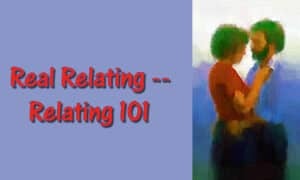
Relating 101 — learning to let go of the past and the future is key to relating… and living

Note: If your present relationship needs work, well…
check out The. Best. Relationship. Ever.
It’s my relationships book… you’ll find all the help you need!

Couples often tell me, “I want to work on our relationship. I typically look around the room, then look confused, and finally say, “OK, I’ll work on it… but where is it? Can you bring it along the next time? Because at the moment, all I see are two individuals, who apparently have trouble relating.”
Sometimes they laugh, sometimes they don’t.
That doesn’t change my point. I have no permanent relationship with anything. All there ever is, is how I am acting, right now, toward the person, place, or thing.
Relating, then, is an activity, not a state.
Second, we cling to beliefs.Now, there are only three ‘times’ — past, present, future — and two of them are an illusion. The present (this endless moment) is real, and is the only place any of us have ever lived. Past and future are totally, completely imaginary.
Surely not! I have a past! An identity!
I did a workshop for injured workers. I mentioned to the workers that much of their suffering comes from clinging to their past — to “how they imagine they were, prior to injury,” and clinging to the future — to their imaginings of “how the pain will be unrelenting and get worse.” One woman walked out at that point and later told someone she hated me because I had the audacity to challenge her story — her misery.
Funny. I thought she was there to change her relationship to her injury and pain, not support it. But clinging to one’s story is a powerful drug.
Here’s how clinging works.
You have a picture in your mind of ‘how things should be.’ The ‘thing’ can be a person, place, or object. So, it might be, “Here is how my husband should be.”
This picture in your head is quite real-seeming and fleshed out. You have spent decades creating this picture of how another should be, and you hold your picture to be both true and real.
It’s neither.
It’s no different than the imaginings of directors of Hollywood movies. Even the most realistic movies are inventions. As are documentaries, which always present the bias of the director / writer. As does this blog, which is totally and completely a reflection of my biases.
Nothing you remember of the past, and nothing you imagine of the future is true. It’s a movie.
Until you get this, you are well and truly stuck in your drama, and are thus condemned to cling.
Back to “the husband” in my illustration. How he is, is how he is, right now, and if I am with him, I get to relate to him, not to my imagined version.
Now, we are predictable, to a certain extent, mostly because we’re boring, stuck, stifled people, but that’s beside the point. I may know what “he” has done in the past, but that, in and of itself, is no predictor.
What I do know is this: if I deal with him as I always have, the odds are the same thing is going to happen.Now, if I am invested in my story of how he ought to be — “everyone knows how a husband ought to act!” — then I am no longer present with the person in front of me. He is compared to my imaginings and comes up short. I then begin a campaign to get him to become who I imagine he ought to be.
This pattern applies to everything — to how I relate to money — “I should be able to spend more, more, more!” To my sex life — “How much, how varied, with whom, etc.” To my job or career — “I should be getting more, and everyone at work should cut me slack.”
In other words, there is the ‘thing’ out there, which I can choose, in the moment, to relate to, and there is the story about the ‘thing’ I have in my head.
Always, there is a story, and a reality.
If I choose to cling to my story, pretending what’s in my head is real, I will suffer.
If I choose to relate, in the moment, to the person, place, or object I am relating to, there may be difficulties, but I will not suffer.
I will not suffer because I am not expecting anything other than ‘what is.’
Is it possible to live this way?Yes, it is.
The key is understanding the movie in your head. You have to completely ‘get’ the concept that your stories are not real, are not predictive, and are not very valuable.
Now, the stories will be there until you die. We are meaning-making creatures, and our meaning-making comes via the films in our heads. Buried in all the sequences are labels, descriptions, warnings. Our safety depends on knowing not to step in front of the onrushing bus.
Beyond that, stories are just stories.Reality is in the moment, and only involves the present choice. Do I listen or shut down? Do I express curiosity, or deliver criticism? Do I stay put or run away? Do I try to keep things “just as they are,” or do I know, deeply, that this is impossible?
As you interact with the things with which you relate, notice how the movies start running. Have a breath and drag your attention back to the moment. Let the stories, the demands, the expectations, fade, and just be present, with curiosity. You may be surprised at how much more interesting the moment becomes.
Facebook TwitterOctober 22, 2023
Real Relating — Some Thoughts on Relating

Some Thoughts on Relating — it’s never a power struggle… it’s learning to see, hear, and appreciate, while staying true to yourself.

Note: If your present relationship needs work, well…
check out The. Best. Relationship. Ever.
It’s my relationships book… you’ll find all the help you need!
I worked with a couple that had really gotten themselves off track. They’d “lived” in a place of verbal violence since the beginning of their relationship and, just before they came in, there’d been a physical violence episode too.
This had sufficiently “scared” both of them that they separated (OK, that part was court ordered, but both agreed) and both entered therapy individually. We worked in that configuration for a while, then shifted, after three months, to couple therapy.There is nothing “easy” or “automatic” about the therapeutic process.
The crap from years of neglect has accumulated. Initially, they thought they’d have to shovel through all the old stuff before they could ever get to the “new stuff.”
One of the toughest “sells,” both in therapy and in life, is this: there is no need, nor is there any way, to resolve the issues of the past.There is not a hope in hell that water, once under the bridge, can be pushed back upstream and filtered until clean. There is letting it go, or letting it own you.
Letting go of the past is neither a pleasant, nor an easy choice.This couple, in “old talk mode,” could loop back 10 years in 30 seconds. They’d be discussing something that was currently happening, and poof, back they’d go, in stages, almost year by year, reminding their partner of past sins.
It was sort of “cute,” as they were polite enough to take turns.
I’d cut them off mid-sentence, and ask them to return to the present moment.I’d ask each of them to reflect on their own “stuff.” I’d ask them to listen to their partner — truly listen — as opposed to deflecting or correcting what the partner is saying.
Because part of growing up is being able to listen to and absorb the validity (to the other person) of what is being said, while not “taking it personally.”
I encouraged them to pick a current topic and to “just talk about it.” I then helped the partner to ask questions designed to ask the partner for more information and more feeling.
When they moved off topic, I’d raise my hand and ask them to go back to the topic at hand.
Initially frustrating, this discipline is essential. What they were trying to learn was self-validation.Often, relationships are used (or perhaps better, the people we are in relationship with are used) to validate us. Even picking a fight with someone is a way insecure people validate themselves.
The incomplete person is saying, “At least, when you fight with me, I know you care, and are still there for me (to use.)”
Another example: incomplete people often possess inflated views of themselves. They say, “See! Look how together I am! (sly look) Don’t you think? (Please validate me.)”As David Schnarch puts it, in Passionate Marriage:
Arguing can be a way of checking that the other person is still there”¦ When we have little differentiation, our identity is constructed out of what’s called a reflected sense of self. We need continued contact, validation and consensus (or disagreement) from others”¦ We develop a contingent identity based on a “self-in-relationship.” Because our identity depends on the relationship, we may demand that our partner doesn’t change so that our identity won’t either. pg. 59
Note: differentiation is a big word with a simple meaning. Poorly differentiated people have weak ego boundaries, and look outside of themselves for identity, validation (approval) and causation (blaming.) Well differentiated people are internally located — they accept responsibility for their lives, their actions, and for their side of all relationships.
In Zen, we might say, “being present without ego attachment.”
In dysfunctional relationships, there is this weird thing going on. Both parties are saying, simultaneously, “Here is the way I am. You’ll just have to accept me this way.” At the same time, they add, “And here are all the things about you that need changing. You’ll change, if you love me.”
All of this is happening for two reasons.
First, the person doesn’t want to have to do the hard work of growing up. They therefore think that the loving action is for their partner to accept them as they are.Second, the person expects that their partner will do the hard work of changing, again to demonstrate their “love.”I find it hard to believe that anyone ever gets away with this crap, but it’s painfully common.Any time I hear a demand (or a manipulation) for external validation, then, I know the person is a fearful infant focussed on staying the same.
The way out, or one way out, is through the process of self-reflective self-revelation. Maybe if I hide, they won’t see me
Maybe if I hide, they won’t see meIt works like this: he (for example) takes the opportunity to express or vent what he is feeling and thinking about a current situation. His situation impacts on her from the perspective of their shared life.
In the past, she’d hear what he was saying and think she had to defend herself. She’d be jumping in, disagreeing, correcting, or picking a fight to get him to stop. With discipline, she is learning to ask him to continue, to dig deep, to tell more of what he knows.
What happens is, without the challenges and provocations, he tells his story as he chooses to, and notices some tears, a lot of sadness, and a feeling of release — doneness.
On “her side of the couch,” her job is to self-soothe and self-validate.She reminds herself that she is not who he thinks she is, and that her “self” will not disappear if he is not focussing on it. His stories are his stories, and as such have nothing to do with her. Her discipline, her “being an adult” is expressed in her willingness to do nothing that will bring the attention off of his story, and back to herself.
When he finishes, it’s her turn to unpack her feelings and thoughts, in the moment.It is emphatically not the time to be clever, to quote a book she just read, or demand that he somehow validate her. She, in other words, does what he just did. She looks deeply at herself. In that process, owns her own “stuff” — the things she does to remain a child.
I remember working with a couple — she’d been to The Haven to do Phase 1, he to a Come Alive. She also was working on a degree in counselling. (She never worked as a therapist. Upon graduating she discovered, to her horror, that she’d be required to “work all the time with people with problems.” But I digress.)
No matter what he did, she’d correct him.
We were in a workshop I was leading. They were practicing breathing. He was breathing, she was coaching. I wandered over. He was doing OK, for a baby breather. She was sobbing.
I asked her what she was troubling herself about. “He’s not doing it right! I tell him and tell him!” Later, as clients, this refrain would repeat. He’d go deep (for him) and reflect on his life. She’d take on the face of someone who was listening intently. He’d stop.
She’d immediately tell him what he did wrong, or she’d say, “You don’t understand how much you hurt me, saying that.” He’d immediately move into trying to make her feel better. When she talked, she’d excoriate him — her entire miserable life was his fault, including the part before he showed up.
Because she saw herself as the great, wise therapist, she avoided any form of working on herself. They were well and truly enmeshed. Her job was to correct him for making her miserable, and he accepted the role willingly.
The way out is the one the couple I earlier described chose… learning to become a self-responsible, self-regulating adult.Learning to do this takes time, will, and effort. It requires a completely different focus and commitment. It requires tools — communication and intimacy tools, honesty and clarity tools, and a knowledge of how to open up and be vulnerable.
Facebook TwitterOctober 9, 2023
Passion, Ego and Charge
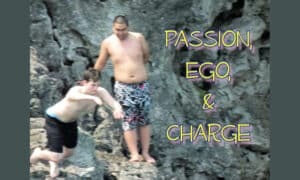
Passion, Ego, and Charge — Because we are conditioned, we view most things through the lens of our culture — this is the job of the ego — to help us conform. Passion and charge exist in the body and pull to mindless pleasure (charge) or to depth, purpose, and meaning. Here’s a bit of information on how to discover them all.
 Psst! Hey!
Psst! Hey!** Want more great writing designed to help YOU to shift your behaviour?
** Want to learn how to find, build or deepen your principal relationship?
** Want to know more about Zen living and being?
Here are a couple of questions, regarding charge, (and the importance of sexual attraction) passion and ego! I do love questions! Keep them coming!
Question # 1:Question # 2
I get your discussion with regard to finding passion in your career path and for the most part in your personal life. The part I get stuck with is with finding a life partner. I was searching for a life partner on a dating site. You meet several men who seem to have similar values and interests when you read their profile and talk with them. Then you meet them and you don’t get the “charge.”
As many write on the site, “let’s meet and see if there is “chemistry” and go from there.” Here is my question: When looking for long term love, does the sexual charge with a partner come with time? If I am not physically attracted to the guy in the early stages of dating him, will the desire to be sexually intimate ever come?
Look forward to reading what you have to say, Wayne. I am sure I am not the only one having this experience.
Michele
So, these two questions, believe it or not, are somewhat related.
I was looking up Passion and Ego in The Relationship Garden. Of course, I thought it would be defined in one paragraph like my medical texts and simplify the two right off the bat, and what world was I in thinking that. Nonetheless I’ve come across some great reading/reminding again before my eyes got too heavy to read in the tub and drop the book in the water.
I digress… Since you are on the topic of Passion, it might be an opportunity, if you don’t already have it planned, to differentiate, compare or present similarities of Passion and Ego. Does ‘good/healthy’ Ego support Passion, or are they the same? But probably I am asking you if you could comment on that, as opposed to it ‘being an opportunity’.
Wendy
The latter question is somewhat “in-house,” as you need to know that “The Relationship Garden” is a book by Ben Wong and Jock McKeen. And I can’t even answer the question directly, as a friend borrowed my copy.
In many of my blog posts, I talk about how we are conditioned by our upbringing.In general, we could say that our parents installed our egos. Parents teach us to fit in to our tribes and cultures. The ego, in this sense (and not in the Freudian use of the term) is the cheerleader / stern taskmaster.
The ego voice boils down to 2 messages:
1) If you try harder, you can be perfect, and2) You idiot! You screwed up again! But… (and return to message 1.)The illustration, below, is the work of Ben and Jock, and describes this ego path — it is the circle I have labelled # 1. (self-hate)The circle to the right of it, labelled # 2 (self-compassion) is what I would call passion . Ben and Jock call this the “Renew Cycle” in The New Manual for Life.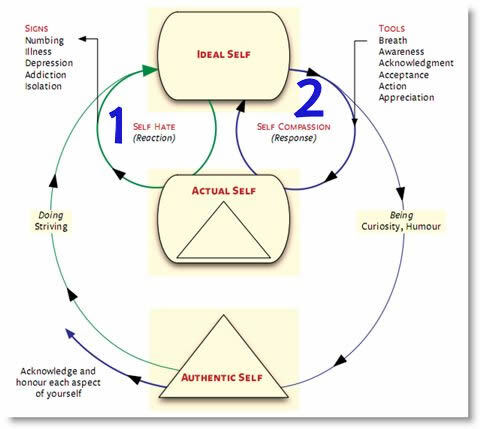 © The Haven, Wong and McKeen, used with permission
© The Haven, Wong and McKeen, used with permissionJust FYI, Freud’s structure of Id, Ego, Super Ego is a clinical / rational model. In Freud’s world, there was no place for things like “purpose” or “vocation,” as those implied a faith position. His main argument with Jung was over Jung’s instance that there was some other spiritual, purposeful element to be taken into account.
But I don’t want to get stuck in semanticsI’m going to remove the Ego word now and replace it with “critical voice.” The Critical Voice, for most, is the dominant sound in the mental theatre. The key to remember is that (as you see in the diagram, # 1) the critical voice is “pitching” perfection as is determined by the ideal state. The upward (green) arrow from Actual to Ideal says, “Try harder.” The downward green arrow says, “You screwed up.” If we don’t learn to set this voice aside, we’re doomed to repeat this endless cycle.
The Ideal Self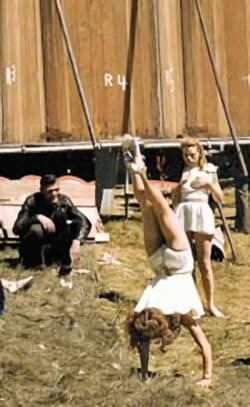 IDEAL Self — It’s decided by your community
IDEAL Self — It’s decided by your communityThe Ideal Self is what a perfect human being would look like, as defined by the social structure we belong to. In other words, each of us carry around a picture in our heads, implanted there by society and family, that we compare ourselves to. Always unfavourably.
Because it is a construct (there has never been an Ideal Person…) it’s a bit like comparing a real apple to an imaginary one. If you make the imaginary one shiny enough, no real apple can compare.
Except, imaginary and ideal do not exist!The Passion or Renewal cycle stands as the “opposite spin.” This cycle or path is about plumbing the depths of The Authentic Self — and the material in there is equal to Jung’s Shadow Side. It’s the material that is unexplored, and the material that our patents and culture taught us to repress.
A Favourite storyI once had a client who wanted to paint. Her parents were doctors, and refused to let her go there, even to the extent of not letting her have art materials, throwing out what she made at school and brought home.
She rebelled by barely passing, becoming a secretary, and having a lot of sex.Then, in her mid-twenties, she painted a quite amazing painting, and then met me. We talked about this, and she went off to study art. Her artist wasn’t gone; she was merely stuck in the “bardo” of the Shadow. She chose to resurrect the artist by… wait for it… finding the artist in her Shadow, then adding her to her Actual Self, by PAINTING!
She learned to stand up to the pull of “what everybody knows,” stopping the attempt to fit in by conforming to the Ideal, and endlessly exploring the deep pool of the Shadow — the Authentic Self.
I call this living with passion.
To the questions:Question # 1) relationships, charge, and passion.Many people are in relationships that seem to lack charge, or strong sexual attraction.
One woman I know worked through the List of 50 exercise from my book, Find Your Perfect Partner — it’s a great way to find a partner that “fits.”
She was puzzled that she never wants to rip his clothes off (otherwise known as sexual charge)If you talk to couples who have had a positive, long-term relationship, you’ll discover a common theme, and that is that there is a ton of passion and not necessarily a ton of charge. Charge diminishes over time, as intimacy grows, because charge requires objectification.
I would go as far as to say that huge charge is always a sign of impending great sex, but that the probability of a deep, intimate relationship emerging is almost zero.Charge is charge, while intimacy and passion are the basis of deep relating.What I’m saying in reply to the first question is this: being turned on by someone is indicative of nothing beyond “chemistry.” Yet, and this is how this fits with the ego question, our cultures (movies, books, etc.) promote sexual charge, and “falling head over heels” as a true marker of a relationship.
Please note! There is a near 50% divorce rate, and we all know scores of others whose “chargy” relationship ended up dead in the water. Sexual charge is a marker for good sex (and perhaps, chemically, we’re picking up the pheromones of a good breeding pair…)
I certainly have had some of those kinds of relationships when I was younger, so I get it. When I finally decided that I wanted a real relationship, I dragged myself kicking and screaming up from my genitals and into my heart. There, I found what, in September, was 40 years and counting of passion and joy.
I would therefore advise simply hanging out with the person, getting to know him, dating, exploring. Approach sex as a fun game and experiment, without letting yourself slide into stopping yourself because you initially aren’t bowled over by charge.You might choose to create an Intimacy Project to explore passion and eroticism through talk and touch. This makes our sexual nature into something more Tantric, significant, and “spiritual.” This puts sex into another niche — a method for deep self-knowing, as opposed to an indicator of “lifelong compatibility.”
And if, after dating for a while, you STILL are uninterested in sex with this person, you then might choose to move on. The odds are, however, that the closer and deeper you go with him, the more “interesting” you will find him, and an altogether more whole sexual experience will open up.
Question 2: Ego and PassionYou might think of ego and passion as oil and water. (Different circles, on the above chart.) Ihe ego is always promoting conformity, which is the opposite of passion. The “voice of passion,” often the quiet voice, is beckoning toward diving into uncharted territory, and living out “stuff” that society is uncomfortable with.
Passion, by definition, is a bit scaryIt starts in the Shadow, and even when we bring it back with us, and begin to live from it, there is still an edge to it. If one’s passion becomes boring and predictable, it has crossed over into the ego side, and becomes a part of the “norm.” (This is why artists stagnate if they are not developing and extending their art.)
Passion is the right hand loop and is always the “Road Less Traveled.” It stands as an alternative to ego.We teach that the ego voice is not “bad” or “wrong.” Many people spend their lives trying to repress the ego voice. They are the people who abandon meditation because they can’t quiet their mind. Of course not. True meditation is letting the voices be — not attaching to them.
Your ego voice will always provide the judgement and the whip to fit in. The passion voice will whisper, “Do your work, explore yourself (figuratively and literally) and dive into the scary stuff.”The ego voice leads to a painful, battle-filled stasis, and the passion voice, to an uncomfortable, diving-filled exploration, and a constant flow and movement. They are two sides of the same coin. You just have to get over fearing being uncomfortable.
The question is: do you want to stay stuck believing what society preaches, stuck in odd relationships that go nowhere, OR do you want to risk sailing into the darkness, confronting your fear of falling over the edge of the Universe, and ending up in unexplored territory?
One is to stay at home and sigh, the other is to risk and move.
No net. No guarantee, other than an adventure enough to fill a lifetime.
Facebook Twitter


